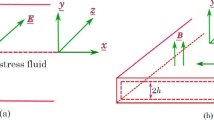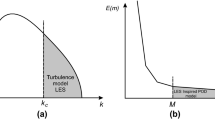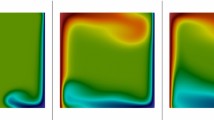Abstract
This paper presents a Krylov subspace projection-based reduced-order model (ROM) for whole microfluidic chip thermal analysis, including conjugate heat transfer. Two key steps in the reduced-order modeling procedure are described in detail: (1) the acquisition of a 3D full-scale computational model in the state-space form to capture the dynamic thermal behavior of the entire microfluidic chip; and (2) the model order reduction using the block Arnoldi algorithm to markedly lower the dimension of the full-scale model. Case studies using practically relevant thermal microfluidic chip are undertaken to establish the capability and to evaluate the computational performance of the reduced-order modeling technique. The ROM is compared against the full-scale model and exhibits good agreement in spatiotemporal thermal profiles (<0.5 % relative error in pertinent time scales) and over three-orders-of-magnitude acceleration in computational speed. The salient model reusability and real-time simulation capability render it amenable for operational optimization and in-line thermal control and management of microfluidic systems and devices.











Similar content being viewed by others
References
Antoulas AC (2005) An overview of approximation methods for large-scale dynamical systems. Annu Rev Control 29(2):181–190
Aurouz PA, Lossifidis D, Reyes DR, Manz A (2002) Micro total analysis systems. 2. Analytical standard operations and applications. Anal Chem 74(12):2637–2652
Bechtold T, Rudnyi EB, Korvink JG, Graf M, Hierlemann A (2005) Connecting heat transfer macromodels for array MEMS structures. J Micromech Microeng 15:1205
Erickson D, Sinton D, Li D (2003) Joule heating and heat transfer in poly (dimethylsiloxane) microfluidic systems. Lab Chip 3(3):141–149
Gui L, Ren CL (2008) Analytical and numerical study of joule heating effects on electrokinetically pumped continuous flow PCR chips. Langmuir 24(6):2938–2946
Hao Q (2004) Analytical heat-transfer modeling of multilayered microdevices. J Micromech Microeng 14:914–926
Lee HW, Arunasalam P, Laratta WP, Seetharamu KN, Azid IA (2007) Neuro-genetic optimization of temperature control for a continuous flow polymerase chain reaction microdevice. J Biomech Eng 129:540–547
Mao H, Yang T, Cremer PS (2002) A microfluidic device with a linear temperature gradient for parallel and combinatorial measurements. J Am Chem Soc 124(16):4432–4435
Odabasioglu A, Celik M, Pileggi LT (1998) PRIMA: Passive reduced-order interconnect macromodeling algorithm. IEEE Trans Comput Aided Des Integr Circuits Syst 17(8):645–654
Qiao R, Aluru NR (2003) Transient analysis of electro-osmotic transport by a reduced-order modelling approach. Int J Numer Meth Eng 56(7):1023–1050
Reyes DR, Lossifidis D, Auroux P-A, Manz A (2002) Micro total analysis systems. 1. Introduction, theory, and technology. Anal Chem 74:2623–2636
Rudnyi EB, Korvink JG (2002) Review: automatic model reduction for transient simulation of MEMS-based devices. Sensors Update 11(1):3–33
Sikanen T, Zwinger T, Tuomikoski S, Franssila S, Lehtiniemi R, Fager CM, Kotiaho T, Pursula A (2008) Temperature modeling and measurement of an electrokinetic separation chip. Microfluid Nanofluid 5(4):479–491
Yang YJJ, Kuo CW (2008) Generating scalable and modular macromodels for microchannels using the Galerkin-based technique. IEEE Trans Comput Aided Design Integr Circuits Syst 27(9):1545–1554
Yang YJ, Shen KY (2005) Nonlinear heat-transfer macromodeling for MEMS thermal devices. J Micromech Microeng 15(2):408–418
Acknowledgments
This research is sponsored by NIH/NHGRI under Grant Number 5R44HG004290-03.
Author information
Authors and Affiliations
Corresponding author
Electronic supplementary material
Below is the link to the electronic supplementary material.
Rights and permissions
About this article
Cite this article
Wang, Y., Song, H. & Pant, K. A reduced-order model for whole-chip thermal analysis of microfluidic lab-on-a-chip systems. Microfluid Nanofluid 16, 369–380 (2014). https://doi.org/10.1007/s10404-013-1210-0
Received:
Accepted:
Published:
Issue Date:
DOI: https://doi.org/10.1007/s10404-013-1210-0




